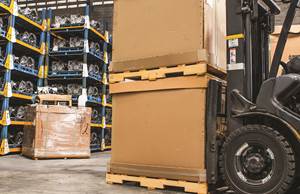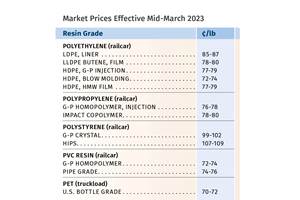The Latest on Materials & Applications for Auto Thermoplastics Composites
Ford, BASF, Borealis, PlastiComp, Asahi Kasei, Arkema, Covestro, Sigmatex, and the National Research Council (NRC) of Canada will present on traditional and ‘hybrid’ carbon-, glass- and natural-fiber reinforced composites, including systems based on polyolefins, PC, liquid reactive resins, bioplastics, and more.
Ford, BASF, Borealis, PlastiComp, Asahi Kasei, Arkema, Covestro, Sigmatex, and the National Research Council (NRC) of Canada will present on traditional and ‘hybrid’ carbon-, glass- and natural-fiber reinforced composites, including systems based on polyolefins, PC, liquid reactive resins, bioplastics, and more.
Want to keep abreast on the latest developments in automotive lightweighting enabled by thermoplastics composites? Do so by
registering for our second presentation of “Thermoplastics Composites for Automotive” (TCC Auto2016) conference on June 15-16 at the Suburban Collection Showcase in Novi, Mich. TCC Auto2016 is presented by Plastics Technology magazine and CompositesWorld, sister publications within Gardner Business Media, and will be concurrent with the Ameriomold 2016 show and conference, presented by Gardner’s MoldingMaking Technology magazine.
Our first unique conference, TCC Auto2014, was a standing-room only event, with over 250 attendees. At next month’s event, over a day and a half, we’ll present 22 speakers on topics in Applications & Materials and Machinery & Processes. Expect TCC Auto2016 to provide cutting-edge information on lightweighting, cost reduction through automation, and new approaches to automotive production for injection molders and composites fabricators.
Materials & Applications will present nine speakers on the first day, starting with a keynote address Driving Innovations and Trends for Next Generation Automotive Composites by Cynthia Flanigan, Ford Motor Co. Here is a brief look at the other eight presentations in this category that are featured on the first day:
• New Automotive Lightweighting Applications Using Carbon- and- Glass-Fiber Reinforced Thermoplastics, Mark Minnichelli, BASF. As automotive OEMs continue to drive forward to meet new CAFE requirements, the value of removing mass from vehicles continues to increase. New innovative thermoplastic materials and processes involving use of carbon fiber and glass fiber are being developed in order to remove mass from vehicle components while maintain needed performance requirements. Several new automotive applications involving these new materials will be shared.
• Fibremod Carbon: An Economical, Lightweight Solution for the Automotive Industry, Sanjay Patel & Tobias Allmendinger, Borealis Group. Borealis, a leading provider of innovative solutions in the field of polyoefins, has developed “revolutionary” carbon-fiber reinforced PP grades based on its proprietary Fibremod technology. This leading-edge technology portfolio already has a proven track record in achieving weight reduction in many automotive applications with the Fibremod series of long- and short-glass PP compounds for the automotive and appliance industries, launched in 2013. This added Fibremod Carbon innovation is expected to help the automotive industry to reap the benefits of carbon-fiber-reinforced thermoplastics such as outstanding density-to-weight ratio, allowing for significant weight reduction and increased functionalization and modularization of components. The excellent economic efficiency of the Fibremod Carbon portfolio will also promote the more widespread use of this potentially revolutionary material in the mass production of automobiles.
• Lower Carbon Fiber’s Cost to Entry Barrier with Long-Fiber Hybrids, Eric Wollan, PlastiComp, Inc. Lightweight carbon-fiber reinforced thermoplastic composites are of increasing interest to the automotive community for their ability to reduce vehicle mass along with associated fuel consumption and emissions. The high price point of carbon fiber presents a barrier to its widespread adoption in the cost-sensitive automotive industry without innovative implementation options. Compounder of long-fiber thermoplastic compounds PlastiComp has developed hybrid long-fiber reinforced thermoplastics composites that combine long glass fiber and long carbon fiber together in a single composite pellet for processing via injection molding. This approach reduces the volume of carbon fiber necessary to obtain higher mechanical performance materials and allows cost-effective long-fiber hybrids to bridge the price gap between all-glass fiber and all-carbon fiber composites.
With most automotive components that can benefit from conversion to long glass fiber composites already accomplished, the industry is in need of more robust thermoplastic material solutions to continue switching more components from metal to structural plastics. Long-fiber hybrids are the ideal segue technology to begin the process of adopting lighter weight carbon fiber as a substitute for metals in components that require performance beyond long glass fiber capabilities. Wollan will present comparative mechanical property data and cost information to explain the performance and economic advantages hybrid long glass and carbon fiber thermoplastics composites offer to the automotive industry.
• Bi-Modal Long-Fiber Technology Provides New Enhancements for Structural Composites, J.P. Wiese, Asahi Kasei Plastics. Various automotive components have utilized long-glass PP products for applications that require a balance of structural strength and excellent impact performance. Thermylene I, the latest innovation from Asahi Kasei Plastics, is a bi-modal long-fiber thermoplastic (LFT) that continues the trend of the replacement of costly high-performance engineered compounds for additional weight and cost advantages over traditional LFTs. Weise will present new developmental data pertaining to the development of glass-reinforced compounds, covering dimensional stability, weight, and a balance of properties.
• Liquid Reactive Thermoplastic Resins for Automotive Applications, Dana Swan, Arkema. As automotive makers strive to meet tighter government standards (CAFE standards 36.6 mpg by 2017 and EU CO2 emission levels 95 g/km by 2020), the explosion of composite materials is increasing. Lightweighting of automobiles with thermoplastics composites brings the advantages of high technical performance, part consolidation, and recyclability of the scrap and final parts. However, technical limitations around processing of traditional thermoplastics has hindered adoption of thermoplastic composites in the industry. Recent developments of a range of liquid reactive thermoplastic resins, marketed under the Elium trade name, has alleviated some of these challenges, Recent research and development in the processing of the resins for automotive applications will be described, Processing methodology include infusion, RTM and HP-RTM.
• Developments in Continuous Fiber-Reinforced Thermoplastic Composites Using Polycarbonate, Paul Platte, Covestro. With increasing demand for lightweighting solutions, thermoplastic composites based on PC resins are a growing alternative to metal or other plastics composite options that target vehicle interior and exterior applications. A new class of thin, lightweight continuous fiber PC composites is under development and will advance composite solutions for the automotive and transportation markets. Continuous fiber PP composites offer designers and engineers high stiffness, impact strength, dimensional stability and class-A surface quality for first-surface and semi-structural applications.
Target automotive applications of door panels, body panels and seat backs have potential for over 40 percent weight reduction compared with aluminum. For commercial buses or heavy trucks where durability and lightweighting are valued, applications such as interior and exterior panels are also envisioned. Additionally, these new continuous fiber PC composites have potential to offer high yield rates and lower coating expense for a manufacturing cost advantage. Designing with thermoplastic composites brings unique challenges not typically seen with traditional metals or unfilled polymers. Designers must have a good understanding of the dimensional and aesthetic capabilities afforded by the continuous fiber PC composite structure.
To consider composites in any semi-structural application, design engineers must be able to accurately predict the part’s performance under static or dynamic structural loads. Manufacturing engineers must be able to anticipate limitations in part design, tooling and forming that may arise which impact the economical production of complex, three-dimensional, high-surface-quality components. Platte will discuss innovations in continuous fiber PC composites, and highlight the progress toward solutions that address the design and manufacturing considerations for application development.
• A Healthy Diet for Automotive Materials: Lightweighting Through Green Thermoplastic Composites, Karen Stoeffler, National Research Council (NRC) Canada. Despite the drastic decrease of oil prices, automotive manufacturers are still under pressure to develop new technologies allowing for the reduction of emissions. Lighter materials, electrification, alternative fuels and vehicle autonomy are some of those technologies. In this presentation, NRC’s Stoeffler will show you how to design lighter and greener thermoplastic composites meeting automotive cost and performance requirements. The topics will include: Thermoplastic compounds based on renewable resources (biobased plastics or natural fibers) for injection molding applications; structural thermoplastic composites integrating higher aspect ratio natural reinforcements by D-LFT; and, how to formulate these materials and how to process them successfully to reach your requirements in terms of mechanical and thermal performance. Specific topics such as VOC control will also be addressed.
• SigmaRF Carbon Thermoplastic Material in Medium-to-High Volume Automotive Applications, Brian Gardner, Sigmatex. The ease of processing a co-mingled carbon thermoplastic material known as SigmRF has been demonstrated in a Sigmatex-led UK Centric Automotive Lightweighting Excellence (LX) Program. Prototype door skins have been produced demonstrating SigmaRF’s capability for medium-to-high volume automotive applications and its tangible benefits of reduced weight, ease of processing, high- volume automotive TAKT time and enhanced mechanical performance over conventional aluminum. The presentation will give an overview of the LX program, the OEMs involved and the role of SignaRF in achieving the objectives.

Related Content
The Fantasy and Reality of Raw Material Shelf Life: Part 1
Is a two-year-old hygroscopic resin kept in its original packaging still useful? Let’s try to answer that question and clear up some misconceptions.
Read MorePrices of Volume Resins Generally Flat or Lower
Exceptions in early March were PP and PS, which moved up solely due to feedstock constraints, along with slight upward movement in PVC and PET.
Read MoreICIS Launches: Ask ICIS Generative AI Commodities Assistant
Said to be the first of its kind, this AI assistant will enhance access to ICIS’ intelligence and insights for the energy and chemical markets.
Read MoreNPE2024 Materials: Spotlight on Sustainability with Performance
Across the show, sustainability ruled in new materials technology, from polyolefins and engineering resins to biobased materials.
Read MoreRead Next
Making the Circular Economy a Reality
Driven by brand owner demands and new worldwide legislation, the entire supply chain is working toward the shift to circularity, with some evidence the circular economy has already begun.
Read MoreFor PLASTICS' CEO Seaholm, NPE to Shine Light on Sustainability Successes
With advocacy, communication and sustainability as three main pillars, Seaholm leads a trade association to NPE that ‘is more active today than we have ever been.’
Read More




























